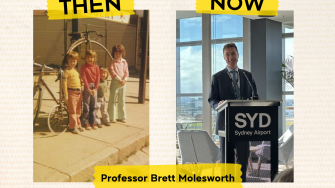Then and Now with UNSW Science Professors
For our professors at UNSW Science, childhood curiosity took them all on different paths to becoming researchers.
For our professors at UNSW Science, childhood curiosity took them all on different paths to becoming researchers.

In following their passions, our professors have expanded our collective understanding, have become mentors, and provided inspiration for new generations of scientists.
We asked five professors to share where their journeys started, their current research and their future aspirations.

What first sparked your interest in science?
I love nature. I always have immense curiosity how it works, efficiently and sustainably for millions of years.
What is your current research focus?
My current research focus on water electrolysers for efficient production of green hydrogen from water, and fuel cells for utilisation of green hydrogen to electrify chemical industry and heavy transportation. I am also using renewable electricity to convert CO2 into useful chemicals and fuels, thus turning the world’s biggest challenges into opportunities.
What are you most looking forward to in your future work?
I like to do things that are important and difficult. In my future work, I look forward to significantly lift the economy viability of green hydrogen technologies by material innovation and device engineering, and to accelerate our transition from an economy dependent on fossil fuels to one founded on clean and sustainable resources.

What first sparked your interest in science?
I don’t remember not being interested, I put together projects on puffins and seals before primary school and was taken to see a public talk on astronomy at a London university when I was 8.
What is your current research focus?
My career has focussed on how galaxies change over time. At the moment I’m testing the current model of galaxy evolution using observations of the really faint stars around distant galaxies which are very sensitive to the mergers that we think play a major role in that evolution. These stars are so faint that they haven’t been observed in substantial samples over the sky but the Rubin Observatory’s upcoming Legacy Survey of Space and Time, opens in a new window will be able to see these over the whole Southern hemisphere.
My team and I are preparing to undertake this research using earlier, significantly smaller surveys as well as computer simulations of the Universe.
What are you most looking forward to in your future work?
In the next year we will start getting observations from Rubin Observatory’s Legacy Survey of Space and Time and I am very excited to start to undertake the research that I have been preparing for over the last 8 years.
And I’ll be HoS of Physics from January next year so that’s a very exciting change in my future work!

What first sparked your interest in science?
My need to understand how we impact the world was first piqued when I explored the eerie abandoned whaling station on Moreton Island when I was eleven.
What is your current research focus?
I became an ecologist and my team and I research impacts on diverse ecosystems, from the seals in the Antarctic, elephants and lions in Botswana, devils in Tasmanian forests, to the recovery of whales in the southern oceans.
What are you most looking forward to in your future work?
Looking forwards, I relish the privilege of helping my students to become international scientists and leaders.

What first sparked your interest in science?
My curious nature. There wasn’t a seminal moment that I can recall – I have always had a curious nature. Psychology was my first passion, and I wanted to understand why pilots were involved in incidents.
What is your current research focus?
My current research focus is a continuation of my PhD topic – predictors of pilots’ risk propensity. This now extends to road and specifically young driver risk management.
What are you most looking forward to in your future work?
I am looking forward to seeing a greater uptake and impact of applied research findings, such as the selection and training of both pilots and young drivers to improve safety for all. In short, making a difference in the real world.

What first sparked your interest in science?
Growing up Mumbai showed me how resourceful people were with waste and unwanted materials, and it always impressed me that people would always try to fix or modify things that were broken and didn’t work. To me, the creation of new and functional products out of things that were supposedly broken was really fascinating. I see my work not just as science and engineering, but as wider social reform.
What is your current research focus?
As the Director of the UNSW Sustainable Materials Research and Technology (SMaRT) Centre, we we are known for pioneering the high temperature transformation of waste in the production of a new generation of ‘green materials’. We are really focussed on next gen R&D and commercialisation for our various innovations including Green SteelTM Polymer Injection TechnologyTM and our MICROfactorieTM Technologies.
What are you most looking forward to in your future work?
In relation to net zero, recovering critical and valuable materials from waste has a big role to play in electrifying the world as we move towards renewable energies and reducing our carbon footprint. The SMaRT Centre continues to pioneer the science and practice of what we call “molecular circularity”, which is to understand at the molecular level the value of waste so it can become feedstock for remanufacturing.
For future sustainability, we believe the future of global manufacturing lies in small-scale, decentralised technologies that will enable communities to produce many of the products, materials and resources they need locally, by largely using inputs that are unwanted or thought of as waste.